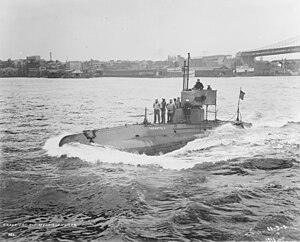 USS B-3, underway near the New York Navy Yard, 1909. USS B-3, underway near the New York Navy Yard, 1909.
| |
| Class overview | |
|---|---|
| Builders | |
| Operators | |
| Preceded by | Plunger class |
| Succeeded by | C class |
| Built | 1906–1907 |
| In commission | 1907–1921 |
| Completed | 3 |
| Retired | 3 |
| General characteristics | |
| Type | Submarine |
| Displacement |
|
| Length | 82 ft 6 in (25.15 m) |
| Beam | 12 ft 6 in (3.81 m) |
| Draft | 10 ft 6 in (3.20 m) |
| Propulsion |
|
| Speed |
|
| Range | 540 nautical miles (1,000 km; 620 mi) (surfaced), 12 nautical miles (22 km; 14 mi) (submerged) |
| Test depth | 150 ft (46 m) |
| Complement | 10 officers and enlisted |
| Armament | 2 × 18 inch (450 mm) bow torpedo tubes (4 torpedoes) |
The B-class submarines were three United States Navy submarines built by the Fore River Shipbuilding Company in Quincy, Massachusetts, under a subcontract from the Electric Boat Company. They were eventually stationed in the Philippines, an American possession, beginning in 1912–15. They were shipped there on colliers (coal-carrying ships). All three were stricken and expended as targets 1919–22.
Design
These were the last submarines designed directly by John Holland. In a series of business organizational moves, Holland had essentially been forced out of Electric Boat by Isaac Rice and Elihu Frost and he resigned from the company on March 28, 1904. They were also the last submarines in the USN with a single, axial mounted propeller until the experimental submarine USS Albacore (AGSS-569) of 1953.
These vessels introduced some features intended to increase underwater speed, including a small sail and a rotating cap over the torpedo tube muzzles. The streamlined, rotating torpedo tube muzzle cap eliminated the drag that muzzle holes would otherwise cause. In the stowed position, the submarine appears to have no torpedo tubes, as the holes in the cap are covered by the bow stem. With the exception of the L-class and the one-off M-1, this feature remained standard for submarines designed by the Electric Boat Company through the O-class, after which it was replaced with individual muzzle doors faired with shutters that remain standard through the modern day.
For extended surface runs, the small sail was augmented with a temporary piping-and-canvas structure (see photo). Tactical doctrine for harbor defense submarines dictated that quick "crash dives" would not be necessary, thus the considerable time it took to dismantle this structure and stow it below was not considered a liability. Experience in World War I showed that this was inadequate in the North Atlantic weather, and earlier submarines serving overseas in that war (E, K, and L-classes) had their bridge structures augmented with a "chariot" shield on the front of the bridge. Starting in 1918-1919, with lessons learned from overseas experience U.S. submarines had bridges more suited to surfaced operations in rough weather.
Boats in class
- B-1 (SS-10), laid down on 5 September 1905, launched on 30 March 1907 as Viper, and commissioned on 18 October 1907, renamed B-1 on 17 November 1911. Decommissioned on 1 December 1921, and used as a target.
- B-2 (SS-11), laid down on 30 August 1905, launched on 1 September 1906 as Cuttlefish, and commissioned on 18 October 1907, renamed B-2 on 17 November 1911. Decommissioned on 12 December 1919, and used as a target.
- B-3 (SS-12), laid down on 5 September 1905, launched on 30 March 1907 as Tarantula, and commissioned on 3 December 1907, renamed B-3 on 17 November 1911. Decommissioned on 25 July 1921, and used as a target.
Citations
- "Quincy's Shipbuilding Heritage". thomascranelibrary.org. Archived from the original on 7 September 2008. Retrieved 16 July 2010.
- Gardiner, p. 127
- Goldstone, pp. 290
- PigBoats.COM B-class Notes section
- Friedman, pp. 75-97
- Friedman pp. 43 & 149
- "Viper / B-1 (SS-10)". navsource.org. Retrieved 16 July 2010.
- "Cuttlefish / B-2 (SS-11)". navsource.org. Retrieved 16 July 2010.
- "Tarantula / B-3 (SS-12)". navsource.org. Retrieved 16 July 2010.
Sources
- Friedman, Norman "US Submarines through 1945: An Illustrated Design History", Naval Institute Press, Annapolis:1995, ISBN 1-55750-263-3.
- Gardiner, Robert, Conway's All the World's Fighting Ships 1906–1921 Conway Maritime Press, 1985. ISBN 0-85177-245-5.
- Goldstone, Lawrence "Going Deep: John Philip Holland and the Invention of the Attack Submarine", Pegasus Books, New York:2017, ISBN 978-1-68177-429-9.
- Silverstone, Paul H., U.S. Warships of World War I (Ian Allan, 1970), ISBN 0-71100-095-6.
- Wright, C. C. (2003). "Question 40/02: Submarines Expended as Targets 1922". Warship International. XL (4): 286–298. ISSN 0043-0374.
External links
| United States B-class submarines | |
|---|---|
| |
| United States naval ship classes of World War I | |
|---|---|
| Dreadnought battleships | |
| Pre-dreadnought battleships | |
| Battlecruisers | |
| Armored cruisers | |
| Protected cruisers | |
| Scout cruisers | |
| Unprotected cruisers | |
| Destroyers | |
| Submarines | |
| Auxiliaries | |
| |